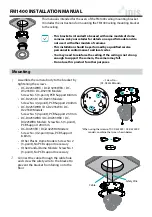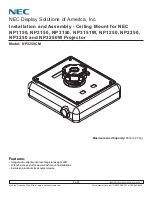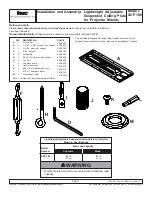
Chapter 4 - Operation and Administration
WILINK I MODULAR BASE STATION SYSTEM MANUAL
142
When set to Off, data packets sent from the Base Station to the backbone will be
transferred with a VLAN tag according to the VPL ID. The VLAN ID in tagged
frames arriving from the wireless network will be replaced by the VPL ID. For
packets received from the network, the forwarding decision will be according to
the Forwarding Rule defined in the Service Profile with a matching VPL ID.
To avoid conflicts, a transparent Service Profile cannot be assigned to a Service if
the Service’s VLAN ID list includes a VLAN ID that is equal to any of the already
assigned VPL IDs.
NOTE
The combination VLAN Transparency Mode On, Hybrid VLAN Mode On and an empty VLAN List
means that only untagged frames should be forwarded. Such a Service cannot be assigned if there
is an assigned non-transparent Service with VPL ID = None.
4.10.4.4.4 VPL ID
A Virtual Private Link ID to be used in the backbone behind the Base Station. The
VPL ID parameter is applicable only to Service Profiles with VLAN Transparency
Mode Off.
To avoid conflicts, it is not allowed to define a VPL ID that is identical to any of
the VLAN IDs in the already assigned transparent Services (Services using a
Service Profile with VLAN Transparency Mode On).
Several Service Profiles may share the same VPL ID. However, the following rules
must be met:
Any number of L2 and/or VoIP Service Profiles may share the same VPL ID,
provided they all use the same Forwarding Rule.
Any number of PPPoE Service Profiles may share the same VPL ID, provided
they all use the same Forwarding Rule.
Any number of L2, VoIP and PPPoE Service Profiles may share the same VPL
ID, provided that all L2/Voice Service Profiles use the same Forwarding Rule
A, and all PPPoE Service Profiles use the same Forwarding Rule B, where A
and B are different.
Available values are in the range of 0 to 4094 or null (empty string) for No VPL ID.
A value of 4095 is displayed for No VPL ID.
4.10.4.4.5 Priority Marking Mode
In some cases, the network operator may want to use the WILINK I system for
marking QoS classes, in order to provide network-wide QoS and enable the
upstream network to handle the traffic accordingly. Within the WILINK I system,
frames can be classified to QoS classes using Priority Classifiers, based on either
a DSCP header or 802,1p tag. This applies only in cases where an external
















































